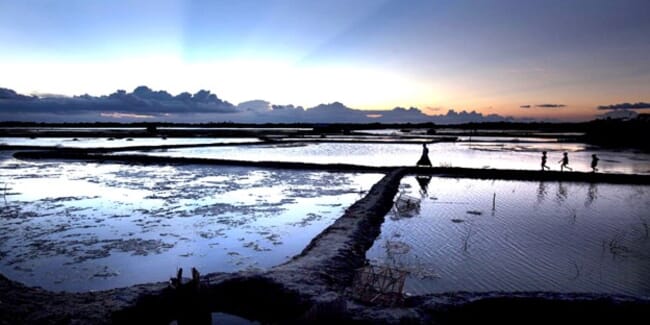
This photo was taken before this summer's extreme drought in the region © Seafood Network Bangladesh
Shrimp farmers in the area have suffered immense losses due to the intense heat and prolonged drought in the last one-and-a-half months. Rajyaswar Das, a shrimp farmer in Sarappur village, disclosed that he lost around USD 27,000 worth of shrimp just as he was about to sell them. This situation is not unique to him, as many shrimp farmers in the district have experienced similar losses.
The dredging of the Mirichchap river has also contributed to the farmers' struggles by causing a shortage of water in their ponds (locally known as Gher). Abdul Bari, another shrimp farmer and trader, reported that 70-80 percent of his shrimp died due to abnormal temperatures when they were still small. The losses incurred by farmers like Das and Bari have had a significant impact on the overall shrimp production in the district.
The general secretary of the Satkhira District Shrimp Growers Association, Abul Kalam Babla, said that approximately 40 percent of all the shrimp died during the intense heat wave, resulting in a loss of more than $1.8 million. Furthermore, the Water Development Board has been dredging the river and temporary dams have been created which are obstructing the water flow. As a result, farmers have been unable to maintain proper water levels, exacerbating the problem caused by the heat, and leading to more shrimp mortalities.
Local district fisheries officer, Anisur Rahman, stated that shrimp cultivation is being conducted in around 60,000 ponds, covering 68,000 hectares of land in Satkhira. However, the farmers are facing various challenges, including a lack of quality shrimp post-larvae (PLs), which results in poor growth and diseased shrimp. Rahman advised the farmers to increase water levels in their enclosures and cultivate shrimp in a healthy and planned environment.
Meanwhile the Koyra upazila in the Khulna district, faces a deadly virus outbreak which has further worsened the situation for Bagda shrimp (P. monodon) farms, mainly caused by drought and water shortage in the enclosures. The increase in salinity levels, resulting from climate change and extreme drought, has aggravated the problem, according to the local government. Farmers like Abdus Sattar Sana and Bhavsindu Mandal have witnessed widespread shrimp mortalities in their ponds.
This issue of dying Bagda shrimp is widespread throughout the upazila and poses a threat to the government's foreign exchange earnings. Koyra is home to approximately 4,000 ponds of various sizes. The target for Bagda shrimp production last year was 6,000 tons, but the mortality rate has hindered achieving that goal.
Aminul Haque, the senior fisheries officer of Koyra upazila, explained that the rising temperatures, due to climate change have contributed to the challenges faced by farmers. Additionally, inadequate water levels in the enclosures have increased salinity levels. The Upazila Fisheries Department is actively providing guidance to the farmers to address these issues and mitigate the adverse effects on shrimp cultivation.
The original version of this feature was initially published as by Seafood Network Bangladesh - an organisation which was established by the author to expand and promote Bangladesh's seafood industry abroad. It has been republished by The Fish Site with the network's kind permission.




